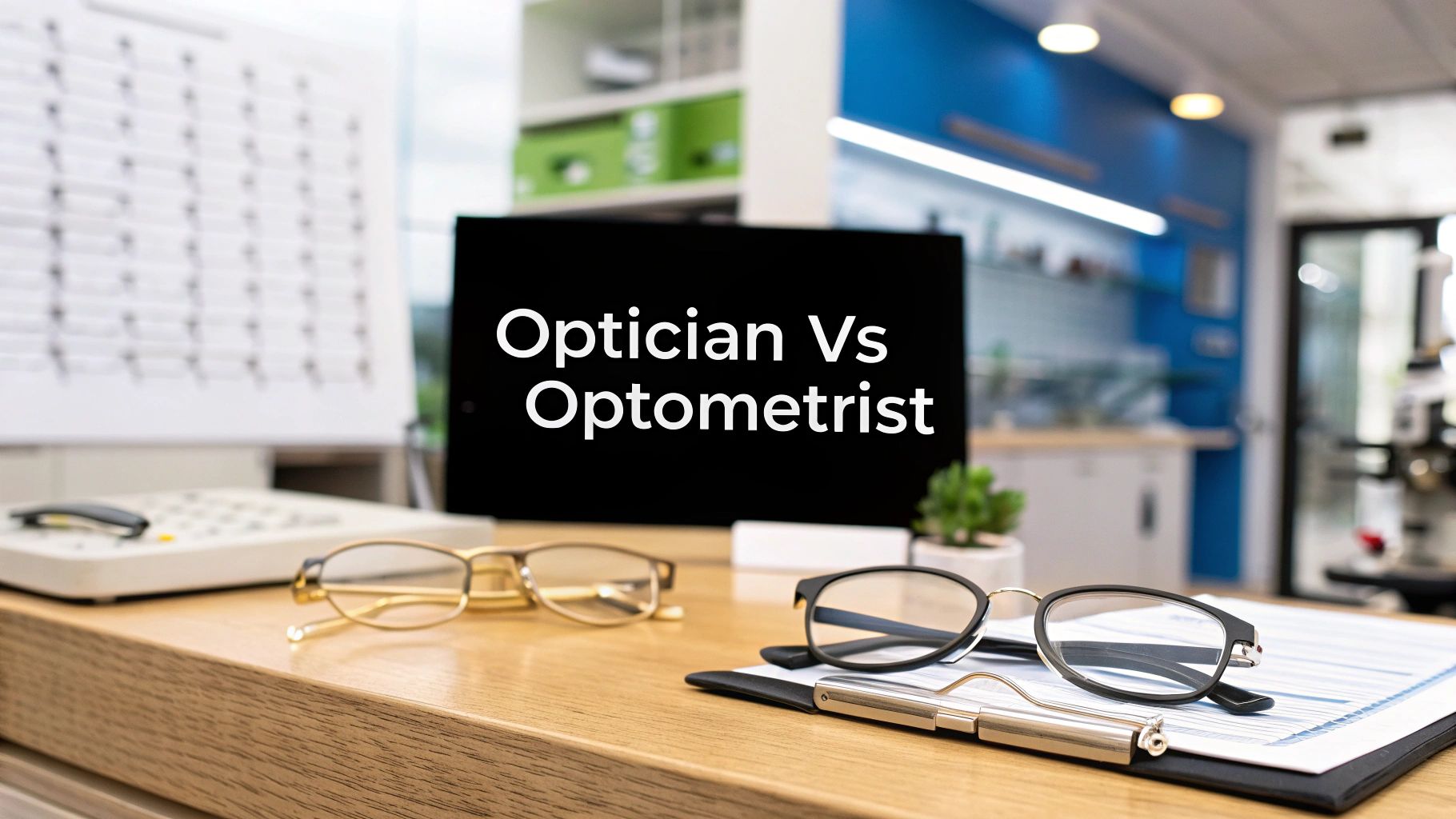.webp)
When it comes to eye care, it's easy to get your 'opticians' and 'optometrists' mixed up. They sound similar, and you often find them in the same place, but their roles are actually quite distinct.
Think of it this way: an optometrist is your primary eye health expert. They're the ones who perform detailed eye examinations, diagnose conditions, and write the prescription you need for clear vision. An optician, on the other hand, is the technical specialist who brings that prescription to life. They help you choose, fit, and maintain your glasses or contact lenses.
Getting your head around the different professionals involved in eye care makes the whole process much smoother. Your optometrist is your first port of call for anything related to the health of your eyes, while an optician handles the practical side of correcting your vision. Although they work hand-in-hand, their responsibilities are very different.
This visual guide breaks down the key distinctions in their training, the services they offer, and their professional authority.
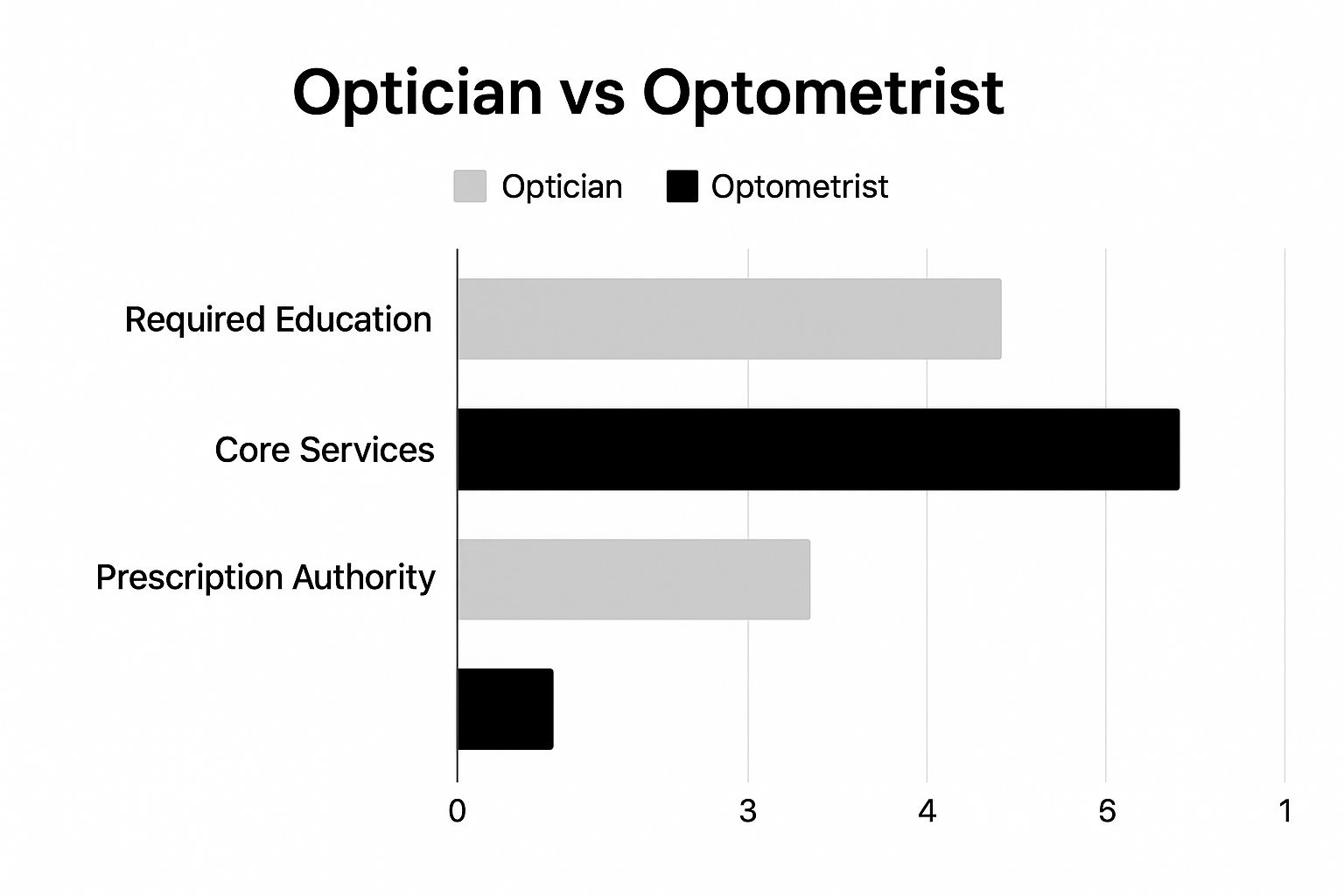
As you can see, the optometrist’s more extensive university education directly translates into a broader scope of practice, including the critical authority to diagnose and prescribe.
To make things even clearer, here’s a straightforward breakdown of their main duties. This table summarises the essential differences, helping you know exactly who to see for what.
This side-by-side view really highlights how the two roles complement each other. Your journey to better vision usually starts with the clinical assessment from an optometrist, and finishes with an optician who ensures your new eyewear is a perfect fit for your lifestyle and needs. Their collaboration is what ensures your vision is not only healthy but also perfectly corrected.
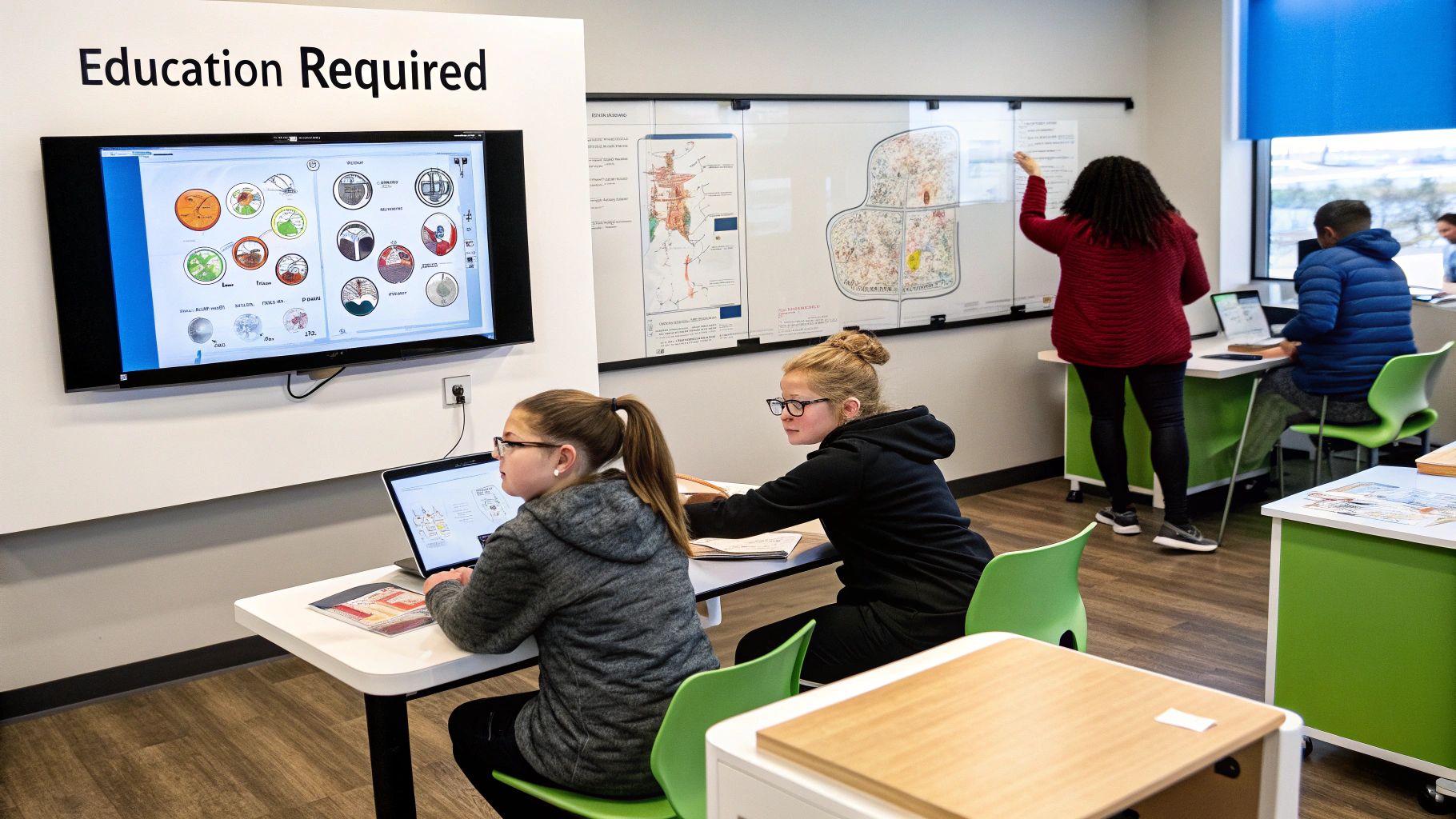
At the heart of the difference between an optician and an optometrist lies their education and training. These distinct paths define their scope of practice and exactly what services they are qualified to provide, ensuring you get the right care from the right professional.
An optometrist’s career starts with a demanding university education. They must earn a BSc (Hons) degree in Optometry, a process that typically takes three to four years of intensive, science-led study.
This degree is just the beginning. After graduating, they enter a mandatory pre-registration year, working full-time under the supervision of a qualified optometrist. It's here they apply their academic knowledge to real-world clinical situations before sitting their final exams to register with the General Optical Council (GOC).
The university curriculum for an optometrist is incredibly comprehensive, moulding them into primary healthcare providers for the eyes. Their training covers a vast range of subjects:
An optometrist’s degree and clinical training equip them to spot signs of systemic health issues like diabetes and high blood pressure, often just by looking at the back of the eye. Their role goes far beyond simply issuing a prescription for glasses.
In contrast, a dispensing optician’s training is more technical and vocational. The focus is squarely on the craft of fitting and supplying eyewear perfectly. They complete a diploma-level qualification, which usually involves two years of blended classroom theory and practical, work-based learning.
This route makes them experts in frames, lenses, and the art of dispensing. While they don't diagnose eye conditions, their skill is what turns an optometrist's prescription into comfortable, effective eyewear. Their specialised training includes:
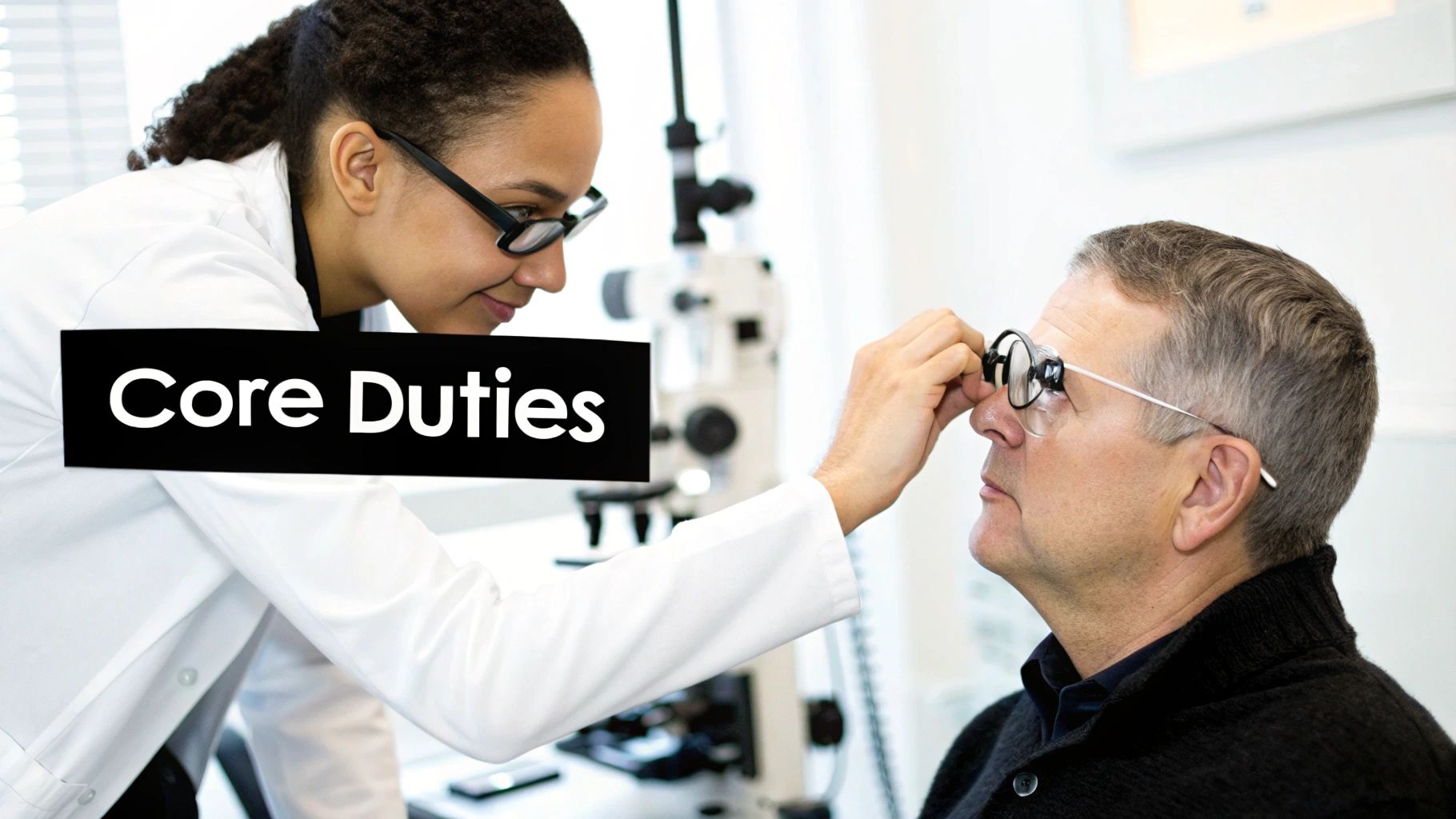
To really get to grips with the difference between an optician and an optometrist, it helps to picture what a typical day looks like for each. Although they often share the same practice, their daily routines are built around completely different skills and responsibilities. This really brings home just how distinct—yet complementary—their roles are in looking after your eyes.
At its core, an optometrist’s day is clinical. It’s a series of patient consultations, diagnostic tests, and health management decisions. Their schedule isn't about selling products; it's about delivering primary healthcare for the eyes.
That means their time is spent carrying out comprehensive sight tests, checking eye muscle coordination, and looking for early warning signs of disease. Think of them as health detectives, hunting for clues that point to both eye conditions and wider systemic health issues.
An optometrist will start their day by reviewing patient files, prepping for a back-to-back schedule of eye examinations. A standard appointment is far more than a quick vision check; it's a deep dive into your ocular health.
For instance, a morning patient might come in complaining of blurry vision. The optometrist will use a phoropter to nail down the precise prescription, but they’ll also use specialist tools like a slit lamp and an ophthalmoscope to examine the internal structures of the eye. This is where their detective work really shines, as they might spot the subtle, early signs of glaucoma or diabetic retinopathy. In fact, an eye exam often serves as a crucial piece of preventive healthcare, much like how blood testing can be an unsung hero of preventive healthcare, giving a window into your overall wellbeing.
An optometrist’s role is proactive. They might spend part of their afternoon managing a patient's dry eye syndrome, prescribing therapeutic eye drops, or referring a patient with suspicious retinal changes to an ophthalmologist for further investigation.
This clinical responsibility is a cornerstone of the profession in the UK, where there are approximately 20,000 optometrists qualified to perform these vital health checks. Their authority to diagnose conditions and write prescriptions is central to their function. You can find out more about the distribution of these eye care professionals with research from Statista.com.
A dispensing optician’s day, on the other hand, is all about technical precision and customer-focused solutions. They are the essential bridge between the optometrist's clinical findings and the patient's daily life, making sure that vision correction is practical, comfortable, and perfectly suited to the individual.
Their day might kick off with helping a client choose the perfect frames—a decision that balances their prescription, face shape, and lifestyle. This demands an encyclopaedic knowledge of materials, from feather-light titanium to durable, flexible plastics, plus a genuine flair for style.
Once the frames are chosen, the optician takes a series of meticulous measurements. This includes the pupillary distance (the gap between your pupils) and optical centres, ensuring the lenses are aligned perfectly with the wearer’s gaze. An error of just a single millimetre can throw off the whole experience and cause visual discomfort.
A large chunk of their day is spent on tasks like:
Ultimately, if the optometrist determines the what (the prescription), the optician masters the how—translating that prescription into a pair of perfectly crafted glasses. Their close collaboration ensures a smooth journey from clinical assessment to crystal-clear, comfortable vision.
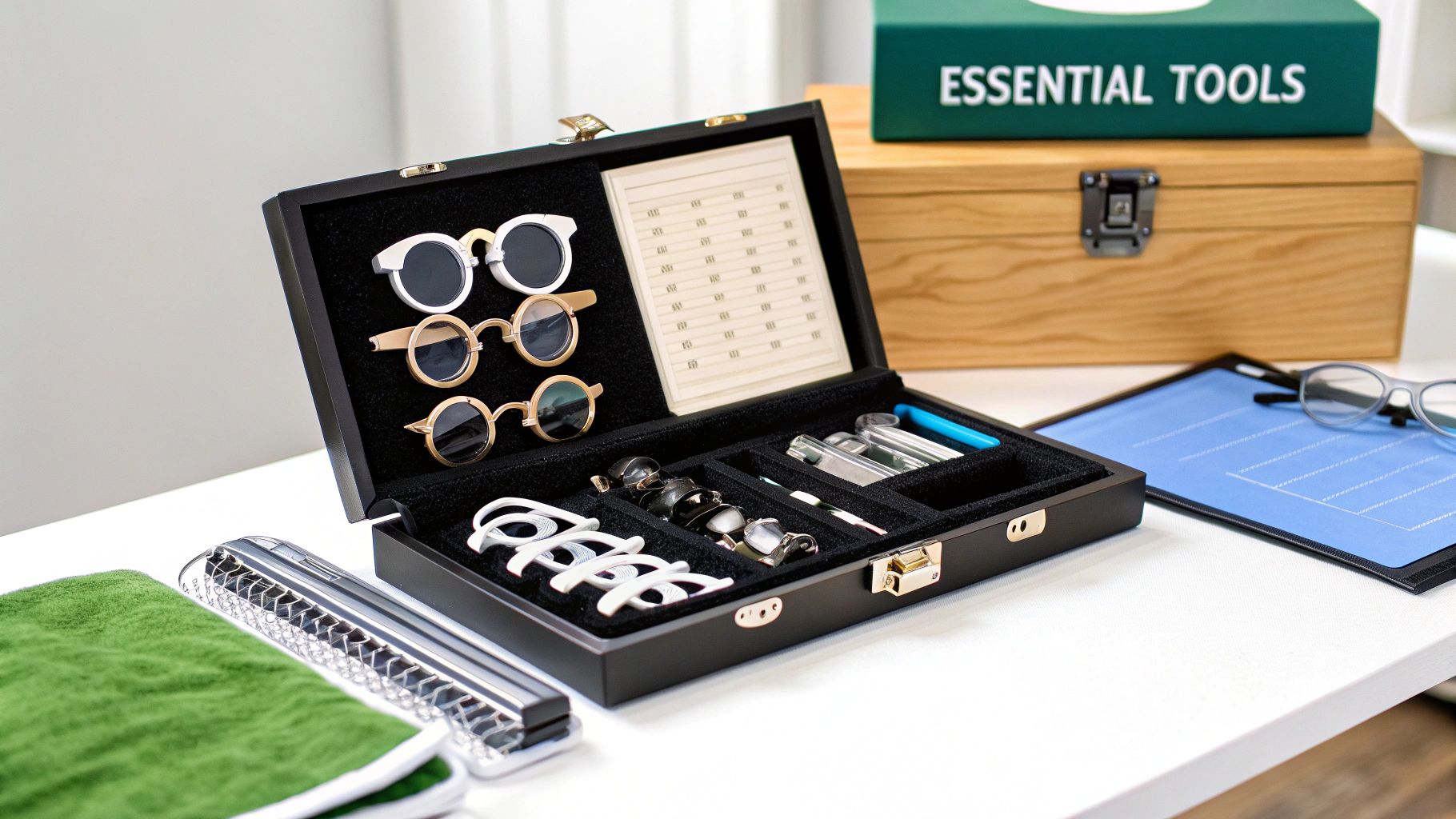
Knowing who to see for your eyes is the first step in getting the right care. The real difference between an optician and an optometrist is their clinical role, and that should always guide your decision. Put simply, if you need a clinical assessment of your eye health, you need an optometrist.
They are your primary eye care providers, acting as the first port of call for any concerns about your vision or the physical health of your eyes. Think of them as the GP for your eyesight.
Your regular eye examination is a cornerstone of preventative health, and it must be carried out by an optometrist. This isn’t just a quick check of your vision; it's a comprehensive health assessment for your eyes, and it’s absolutely vital for spotting problems before they become serious.
You should also book an appointment straight away if you notice any sudden or unusual symptoms. These are clear warning signs that demand a proper clinical evaluation:
An optometrist is the only professional authorised to perform a sight test and issue a new prescription for glasses or contact lenses. If your vision feels different or it has been more than two years since your last test, it is time to schedule a visit.
An optometrist is also your long-term partner in managing your eye health. Their training allows them to detect and monitor a massive range of conditions, making sure you receive consistent and appropriate care over time.
For instance, they play a crucial role in managing conditions like dry eye syndrome, glaucoma, and cataracts. If you have a family history of eye disease or a health issue like diabetes that can impact your vision, regular consultations are essential.
To get the best primary eye care, it helps to understand how finding the best optometrist for your needs works. At the end of the day, if your concern is about the health of your eyes or the quality of your vision, the optometrist has the clinical expertise needed to give you a diagnosis and a treatment plan. They are the true gatekeepers to your overall eye health.
Once your optometrist has handed you a valid prescription, the dispensing optician takes over. Think of them as the technical specialist who translates the clinical data from your eye test into perfectly crafted, comfortable eyewear. While the optometrist is focused on your eye health, the optician is an expert in the final product you’ll wear every day.
You should book in with an optician when you're ready to choose and buy new glasses. They have a deep understanding of lens materials, coatings, and frame designs, guiding you through the maze of options to find the best fit for your vision, face shape, and lifestyle. This is where their expertise really comes into its own.
A dispensing optician is your go-to professional for any physical issues with your eyewear. Their skills are essential for making sure your glasses don't just work well but feel great too.
Key situations that call for an optician include:
When it's time to pick your frames and lenses, their guidance is invaluable, and they can offer expert tips on how to choose eyeglasses that truly suit you.
The simplest way to understand the difference is this: an optician’s work begins where the optometrist’s eye examination ends. They are responsible for the physical creation and ongoing maintenance of your eyewear.
Dispensing opticians also play a big part in managing contact lenses. After an optometrist performs the initial health check and fitting, it's often the optician who handles the ongoing supply and provides crucial hands-on training. They’ll teach you the correct way to insert, remove, and care for your lenses to keep them comfortable and hygienic.
Their technical insight is also critical for anyone with a complex prescription. If you have a high degree of astigmatism or need multifocal lenses, their ability to take exact measurements and advise on the right lens technology is essential. While an optometrist diagnoses conditions like cataracts, it’s the optician who helps you select the appropriate eyewear after surgery. You can learn more about how these roles connect when dealing with conditions like cataracts and see the full patient journey.
Think of an optometrist and an optician as two specialists in a relay race for your vision. They aren't rivals; they’re a team, and understanding how they hand the baton to one another makes the entire process of getting glasses or contact lenses much clearer.
Your journey almost always starts with the optometrist. They are your primary eye health doctor. Their job is to perform a detailed clinical exam, checking not just your vision but the complete health of your eyes. This is the diagnostic stage, where they identify your precise prescription and screen for any underlying health issues.
Once the examination is over, the optometrist gives you your prescription. This is where the smooth handoff happens, and the dispensing optician steps in.
A dispensing optician takes the clinical data from your prescription and turns it into real-world eyewear. They are the technical experts who guide you through the maze of frame styles, lens materials, and coatings, ensuring what you choose is perfectly suited to your lifestyle, face shape, and visual needs.
The key thing to remember is that great eye care is a two-part process. The optometrist handles your eye health and the numbers on your prescription. The optician handles the physical craft of creating and fitting the eyewear that brings those numbers to life.
This partnership is reflected right across the UK's professional landscape. As of November 2022, there were 17,134 registered optometrists handling clinical sight tests—a figure that grew by 5% in just over a year. Supporting them were 6,586 dispensing opticians, the specialists who turn prescriptions into perfectly fitted glasses. The General Optical Council’s research offers a deeper dive into the mapping of optical businesses in the UK.
Sometimes, an optometrist might spot an issue that needs more advanced medical or surgical attention. In these cases, they’ll refer you to a consultant. To understand this next level of care, you can read our guide to ophthalmology services. This complete pathway gives you total peace of mind, knowing every aspect of your vision is in expert hands.
It’s easy to get confused about who does what. Let’s clear things up by tackling a few of the most common questions people have. Knowing the difference between an optician and an optometrist helps you get to the right professional, right away.
No, an optician cannot perform a clinical eye test. This is probably the most critical distinction to remember. An eye examination is a detailed medical check-up of your vision and the health of your eyes, and that responsibility lies solely with a qualified optometrist.
An optician’s expertise kicks in after the eye test. They take the prescription written by an optometrist and use their technical skills to fit and supply your eyewear. They are not trained or legally authorised to conduct sight tests or diagnose eye conditions.
Yes, you absolutely must see an optometrist for your initial contact lens assessment and to get a prescription. While a dispensing optician can handle your ongoing supply and show you how to care for your lenses, the first fitting is a clinical procedure.
An optometrist will carry out a thorough check to make sure your eyes are healthy enough for contact lenses. They'll also determine the exact type, material, and fit for your specific needs, which is crucial for both your comfort and safety.
The eye care picture isn’t complete without the third key professional: the ophthalmologist. They are medical doctors who have gone on to specialise in eye surgery and the management of complex eye diseases.
Think of the relationship like this: An optometrist is your eye GP, providing primary care and prescriptions. An optician is the technician who creates your glasses. An ophthalmologist is the hospital consultant or surgeon for advanced medical and surgical eye problems.
Your optometrist will refer you to an ophthalmologist if they spot a condition that needs specialised medical or surgical treatment beyond their scope. This could be anything from advanced glaucoma to cataracts that require surgery.
At The Vesey Private Hospital, our expert ophthalmology team works closely with community optometrists to provide seamless, specialised care when you need it most. Discover more about our patient-focused approach by visiting us at https://www.thevesey.co.uk.

